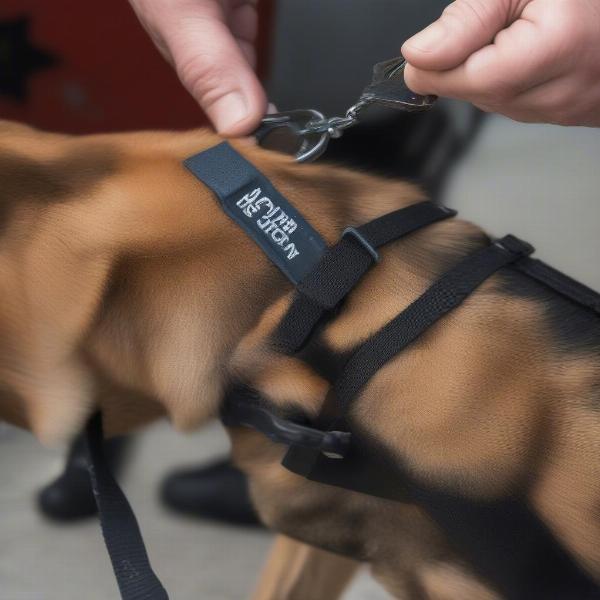A police dog lead, also known as a K9 lead, is a crucial piece of equipment for any handler. It’s the vital link between officer and dog, ensuring control, safety, and effective teamwork. Selecting the appropriate lead goes beyond just finding a strong rope; it involves considering the dog’s breed, size, training level, and the specific tasks they perform. This article will explore the different types of police dog leads available, the factors to consider when choosing one, and how to properly use and maintain it for optimal performance.
Types of Police Dog Leads
There are several types of police dog leads designed for various purposes and handling styles. Each offers unique benefits and drawbacks, making it essential to understand their characteristics.
-
Leather Leads: Known for their durability and classic look, leather leads offer a firm grip and are often preferred for general patrol work. However, they require regular conditioning to prevent cracking and can become heavy when wet.
-
Nylon Leads: Lightweight and weather-resistant, nylon leads are a popular choice for their versatility. They come in various lengths and widths, making them suitable for different training scenarios and dog sizes.
-
Biothane Leads: Combining the best of both worlds, biothane leads offer the strength and durability of leather with the water-resistance and easy maintenance of nylon. They are a great option for working dogs in all weather conditions.
-
Chain Leads: Primarily used for control and correction during training, chain leads offer a firm grip and can deter pulling. However, they should be used with caution and under the guidance of a professional trainer.
Factors to Consider When Choosing a Police Dog Lead
Choosing the right police dog lead requires careful consideration of several key factors.
Dog Size and Breed
Larger, more powerful breeds require stronger and wider leads than smaller breeds. The lead should be able to withstand the dog’s strength and prevent breakage, ensuring both the dog’s and the handler’s safety.
Training Level and Temperament
For dogs still in training, a longer lead might be necessary to allow for greater freedom of movement. Dogs with a tendency to pull might benefit from a shorter, more controlled lead or a specific type like a slip lead.
Intended Use
The type of work the dog performs also influences lead selection. A tracking dog might require a longer, lighter lead for trailing, while a patrol dog might need a shorter, more robust lead for close-quarters control.
Using and Maintaining Your Police Dog Lead
Proper use and maintenance are crucial for extending the life of your police dog lead and ensuring its effectiveness. Always inspect the lead for wear and tear before each use, and replace it if any damage is found.
Proper Grip and Handling
Maintaining a proper grip on the lead is essential for control and preventing injuries. Avoid wrapping the lead around your hand, as this can cause burns or restrict blood flow.
Cleaning and Storage
Clean your lead regularly according to the manufacturer’s instructions. Leather leads require conditioning to prevent drying and cracking. Store your lead in a cool, dry place away from direct sunlight.
What are the benefits of using a police dog lead?
A police dog lead provides control, ensures safety, and facilitates effective communication between handler and dog, enabling them to work as a cohesive team.
How do I train my dog to use a police dog lead?
Training a dog to use a police dog lead should be done gradually and positively, starting with short sessions and rewarding good behavior. Professional guidance is recommended for optimal results.
FAQ
- What is the ideal length for a police dog lead? The ideal length varies depending on the intended use and the dog’s training level. Generally, leads range from 4 to 6 feet for patrol work and longer for tracking.
- What material is best for a police dog lead? The best material depends on individual needs and preferences. Leather, nylon, and biothane are popular choices, each offering unique benefits.
- How often should I replace my police dog lead? Inspect your lead regularly and replace it immediately if you notice any signs of wear or damage.
- Can I use a regular dog lead for police work? While a regular lead might suffice temporarily, a dedicated police dog lead is designed for the specific demands of police work and is recommended for optimal performance and safety.
- Where can I buy a police dog lead? Police dog leads can be purchased from specialized K9 equipment suppliers, both online and in physical stores.
 Maintaining a Police Dog Lead
Maintaining a Police Dog Lead
For further information on dog care and training, check out these related articles:
About ILM Dog
ILM Dog is your global resource for expert dog care advice, offering practical guidance on everything from breed selection and puppy care to senior dog health and specialized training techniques. We’re committed to providing evidence-based information and valuable resources to help dog owners worldwide ensure the well-being of their canine companions. Whether you’re a new dog owner or a seasoned expert, ILM Dog is your trusted partner in navigating the joys and challenges of dog ownership. Contact us at [email protected] or +44 20-3965-8624 for personalized advice and support.